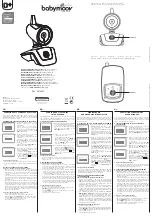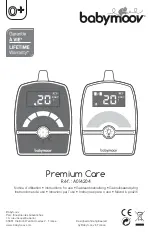
FMHD-1 Operator’s Manual
Page 20
FMHD-1
normal transmission of stereo program material. Six tri-color bar graphs indicate modulation of the
Left (L) and Right (R) audio channels, Stereo Pilot, the L+R (or sum channel), the L–R (or difference
channel), as well as the Total modulation of the FM carrier.
The horizontal axis, or x axis is marked in “
%
” (percent), where 100% corresponds to 75 kilohertz peak
deviation of the FM carrier. Numerical readouts of the peak readings appear to the right of the respective
bars in the display.
The right edge of the red portion of each bargraph indicates the Peak value of the modulation as a
function of time. The right edge of the yellow portion of the bars indicates the average value of
modulation, and the right edge of the green portion of the bars indicates the minimum value over the
metering time window. (For a description of bar-graph metering, see
FMHD-1
Bargraph Displays on
page 1414, above. For details about the metering characteristics, refer to the parameters immediately
under the heading “Unit Settings Popup Menu” on page 25, below.)
“Total” is the top bar graph of the display. It shows the deviation of the FM carrier, and represents the
instantaneous sum of all the components making up the baseband signal which modulates the analog FM
carrier. This is the most important analog reading. It includes the stereo composite signal (which includes
the sum and difference channels and the stereo pilot), the RDS signal if present, as well as any noise and
distortion present on the FM carrier.
“Pilot” is the level of the 19-kHz sine wave used to synchronize the stereo demodulation in FM stereo
receivers. This is normally set to 9.0% modulation, or 6.75 kHz peak deviation. Because it is a steady
tone, only a yellow RMS indication is shown.
Left and Right indications show the modulation of the FM carrier due to the left and right program audio.
Here, 100% corresponds to 75 kHz peak deviation of the carrier. For normal operation, maximum Left
and Right modulation is 90%, leaving 10% for the modulation of the carrier by the 19-kHz stereo Pilot
signal.
At the bottom of this screen are the L+R and L–R bargraphs. The L+R is literally the sum of the Left and
Right channel signals and represents the level of the audio program present on a monaural FM receiver.
(It is also that component of the composite stereo signal falling below 15 kHz.) The L–R reading indicates
the level of the stereo sub-channel. (The stereo sub-channel is the double-sideband suppressed-carrier
component of the FM composite signal resulting from modulation of the 38-kHz sub-carrier by the L–R
audio difference information.) Normally, it is good practice to maintain the L+R signal fairly high, but
less than 90%. The L–R peak levels depend on the stereo content of the audio program material. Except
for unusual program material, the L–R level will fluctuate well below 90%. Its reading may approach zero
for well-balanced monaural program sources.
There are no user-controllable settings accessible from this screen.
5.6
Time Alignment Screen
Though referred to as the Time Alignment Screen, this screen provides information about the relative
polarity, time alignment and amplitudes of the analog FM and hybrid IBOC HD™ main program streams.
This information is important to assure sonically smooth blending of the analog and digital HD audio
when receivers transition between the two modes.
Содержание FMHD-1
Страница 1: ...BELAR Broadcast Equipment FMHD 1 FM HD RADIO MONITOR ...
Страница 4: ......
Страница 8: ...FMHD 1 Operator s Manual ...
Страница 55: ...FMHD 1 Operator s Manual BELAR ELECTRONICS LABORATORY INC Page 47 ...
Страница 56: ......
Страница 57: ......
Страница 58: ...BELAR ELECTRONICS LABORATORY INC ...
















































